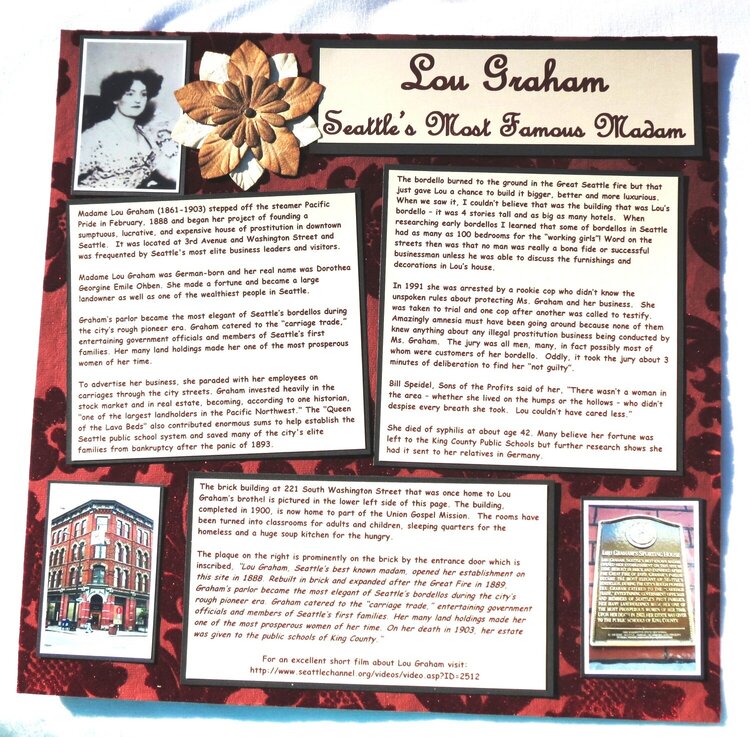Plus, a FREE Gift! | Details Here.


 Give a Cheer
Give a Cheer
Madame Lou Graham (1861-1903) stepped off the steamer Pacific Pride in February, 1888 and began her project of founding a sumptuous, lucrative, and expensive house of prostitution in downtown Seattle. It was located at 3rd Avenue and Washington Street and was frequented by Seattle's most elite business leaders and visitors.
Madame Lou Graham was German-born and her real name was Dorothea Georgine Emile Ohben. She made a fortune and became a large landowner as well as one of the wealthiest people in Seattle.
Graham's parlor became the most elegant of Seattle's bordellos during the city's rough pioneer era. Graham catered to the “carriage trade,” entertaining government officials and members of Seattle's first families. Her many land holdings made her one of the most prosperous women of her time.
To advertise her business, she paraded with her employees on carriages through the city streets. Graham invested heavily in the stock market and in real estate, becoming, according to one historian, "one of the largest landholders in the Pacific Northwest." The "Queen of the Lava Beds" also contributed enormous sums to help establish the Seattle public school system and saved many of the city's elite families from bankruptcy after the panic of 1893.
The bordello burned to the ground in the Great Seattle fire but that just gave Lou a chance to build it bigger, better and more luxurious. When we saw it, I couldn't believe that was the building that was Lou's bordello – it was 4 stories tall and as big as many hotels. When researching early bordellos I learned that some of bordellos in Seattle had as many as 100 bedrooms for the “working girls”! Word on the streets then was that no man was really a bona fide or successful businessman unless he was able to discuss the furnishings and decorations in Lou's house.
In 1991 she was arrested by a rookie cop who didn't know the unspoken rules about protecting Ms. Graham and her business. She was taken to trial and one cop after another was called to testify. Amazingly amnesia must have been going around because none of them knew anything about any illegal prostitution business being conducted by Ms. Graham. The jury was all men, many, in fact possibly most of whom were customers of her bordello. Oddly, it took the jury about 3 minutes of deliberation to find her “not guilty”.
Bill Speidel, Sons of the Profits said of her, “There wasn't a woman in the area – whether she lived on the humps or the hollows – who didn't despise every breath she took. Lou couldn't have cared less.”
She died of syphilis at about age 42. Many believe her fortune was left to the King County Public Schools but further research shows she had it sent to her relatives in Germany.
The brick building at 221 South Washington Street that was once home to Lou Graham's brothel is pictured in the lower left side of this page. The building, completed in 1900, is now home to part of the Union Gospel Mission. The rooms have been turned into classrooms for adults and children, sleeping quarters for the homeless and a huge soup kitchen for the hungry.
The plaque on the right is prominently on the brick by the entrance door which is inscribed, “Lou Graham, Seattle's best known madam, opened her establishment on this site in 1888. Rebuilt in brick and expanded after the Great Fire in 1889, Graham's parlor became the most elegant of Seattle's bordellos during the city's rough pioneer era. Graham catered to the “carriage trade,” entertaining government officials and members of Seattle's first families. Her many land holdings made her one of the most prosperous women of her time. On her death in 1903, her estate was given to the public schools of King County.”
For an excellent short film about Lou Graham visit: http://www.seattlechannel.org/videos/video.asp?ID=2512
If it doesn't come up immediately, scroll down to the “Ballad of Lou Graham”
A couple contradictions – if the building is law offices or government buildings now, then it was a Mission before. Also, some research shows she gave the money to the public schools but more convincing research (in my opinion) says that is a myth – it went to relatives in Germany.
No products have been added to this project.
Thanks for spreading positivity!
September 29, 2020
May 08, 2013
March 10, 2013
February 28, 2013
February 26, 2013
February 24, 2013
February 22, 2013
February 19, 2013
February 19, 2013
February 18, 2013
February 17, 2013
February 17, 2013
February 17, 2013
February 17, 2013
February 17, 2013
February 17, 2013
February 17, 2013
February 17, 2013